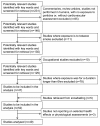Cardiovascular effects of sub-daily levels of ambient fine particles: a systematic review
- PMID: 20550697
- PMCID: PMC2895599
- DOI: 10.1186/1476-069X-9-26
Cardiovascular effects of sub-daily levels of ambient fine particles: a systematic review
Abstract
Background: While the effects of daily fine particulate exposure (PM) have been well reviewed, the epidemiological and physiological evidence of cardiovascular effects associated to sub-daily exposures has not. We performed a theoretical model-driven systematic non-meta-analytical literature review to document the association between PM sub-daily exposures (< or =6 hours) and arrhythmia, ischemia and myocardial infarction (MI) as well as the likely mechanisms by which sub-daily PM exposures might induce these acute cardiovascular effects. This review was motivated by the assessment of the risk of exposure to elevated sub-daily levels of PM during fireworks displays.
Methods: Medline and Elsevier's EMBase were consulted for the years 1996-2008. Search keywords covered potential cardiovascular effects, the pollutant of interest and the short duration of the exposure. Only epidemiological and experimental studies of adult humans (age > 18 yrs) published in English were reviewed. Information on design, population and PM exposure characteristics, and presence of an association with selected cardiovascular effects or physiological assessments was extracted from retrieved articles.
Results: Of 231 articles identified, 49 were reviewed. Of these, 17 addressed the relationship between sub-daily exposures to PM and cardiovascular effects: five assessed ST-segment depression indicating ischemia, eight assessed arrhythmia or fibrillation and five considered MI. Epidemiologic studies suggest that exposure to sub-daily levels of PM is associated with MI and ischemic events in the elderly. Epidemiological studies of sub-daily exposures suggest a plausible biological mechanism involving the autonomic nervous system while experimental studies suggest that vasomotor dysfunction may also relate to the occurrence of MI and ischemic events.
Conclusions: Future studies should clarify associations between cardiovascular effects of sub-daily PM exposure with PM size fraction and concurrent gaseous pollutant exposures. Experimental studies appear more promising for elucidating the physiological mechanisms, time courses and causes than epidemiological studies which employ central pollution monitors for measuring effects and for assessing their time course. Although further studies are needed to strengthen the evidence, given that exposure to sub-daily high levels of PM (for a few hours) is frequent and given the suggestive evidence that sub-daily PM exposures are associated with the occurrence of cardiovascular effects, we recommend that persons with cardiovascular diseases avoid such situations.
Figures
References
-
- Brook RD, Franklin B, Cascio W, Hong Y, Howard G, Lipsett M, Luepker R, Mittleman M, Samet J, Smith SC Jr, Tager I. Expert Panel on Population and Prevention Science of the American Heart Association. Air pollution and cardiovascular diseases: A statement for health care professionals from the Expert Panel on Population and Prevention Science of the American Heart Association. Circulation. 2004;190:2655–2671. doi: 10.1161/01.CIR.0000128587.30041.C8. - DOI - PubMed
-
- U.S. Environmental Protection Agency. Air Quality Criteria for Particulate matter. Washington, DC. 2004.
-
- Cooper H, Hedges LV. The handbook of research synthesis. NY: Russell Sage Foundation; 1994.
Publication types
MeSH terms
Substances
LinkOut - more resources
Full Text Sources



